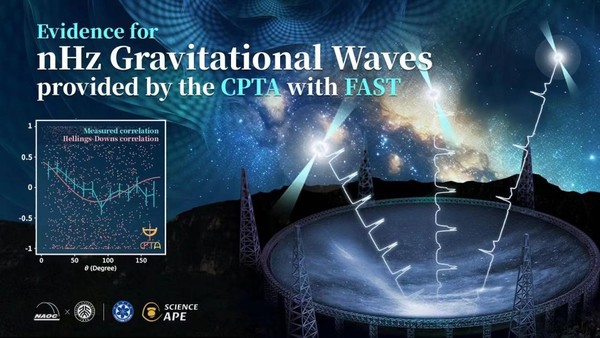By Wu Yuehui, People's Daily
China's Five-hundred-meter Aperture Spherical Radio Telescope (FAST) recently found key evidence for the existence of nanohertz gravitational waves.
The research was conducted by the Chinese Pulsar Timing Array (CPTA) collaboration, which comprises researchers from the National Astronomical Observatories of the Chinese Academy of Sciences (NAOC) and other institutes. Their findings were published online in the academic journal Research in Astronomy and Astrophysics (RAA) on June 29.

The finding indicates China's leading position in the world in terms of the studies on nanohertz gravitational waves.
According to Albert Einstein's theory of general relativity, space-time is curved. Acceleration of massive objects disturbs the surrounding space-time and produces "ripples" which are known as gravitational waves.
Li Kejia, a researcher with the NAOC, told People's Daily that the detection of nanohertz gravitational waves helps astronomers better understand the origins of the universe.

The signals of gravitational waves are extremely weak, but they offer a direct method for probing masses that do not emit light. Therefore, astronomers have long aimed to detect and use gravitational waves to aid in the observation of the universe.
Objects of greater mass produce gravitational waves of lower frequency. "For example, the most massive celestial body in the universe, the supermassive black hole binaries in the center of galaxies, mainly generate gravitational waves in the nanohertz band," said Li.
Using nanohertz gravitational waves in cosmic observation is thus hugely important in studying key problems in contemporary astrophysics such as supermassive black holes, the history of galaxy mergers, and the formation of large-scale structures in the universe. Global physicists and astronomers have been racing to detect nanohertz gravitational waves.
Xu Heng, associate researcher with the NAOC noted that the detection of nanohertz gravitational waves can be very challenging due to their extremely low frequency, where the corresponding period can be as long as several years and wavelengths up to several light-years.
"Using FAST-like large radio telescopes to conduct long-term timing observation of millisecond pulsars with extreme rotational stability is the only known method for effectively detecting nanohertz gravitational waves," he added.
Regional pulsar timing array collaborations, including the North American Nanohertz Observatory for Gravitational Waves, the European Pulsar Timing Array and the Australian Parkes Pulsar Timing Array, have been collecting pulsar timing data for more than 20 years, with the aim of detecting nanohertz gravitational waves.
Taking advantage of FAST's high sensitivity, the CPTA research team monitored 57 millisecond pulsars, which formed a Galactic-scale gravitational wave detector sensitive to nanohertz gravitational waves. They found key evidence for quadrupole correlation signatures compatible with the prediction of nanohertz gravitational waves at a 4.6-sigma statistical confidence level(with a false alarm probability of two in a million).
The team used independently developed data analysis software and data processing algorithms to achieve its breakthrough at the same time as other international groups. Independent data processing pipelines produced compatible results.
Luis C.Ho, Chair Professor of Peking University noted that it was a scientific prediction that the mergers of supermassive blackholes produce nanohertz gravitational waves, and this long-anticipated prediction has finally been proved by the CPTA research team.
Ho called the finding an important scientific breakthrough that carries lasting and huge significance. It not only has profound impacts on the study of galaxy evolution and supermassive blackholes, but also has opened a brand-new window for gravitational-wave astrophysics, he noted.

